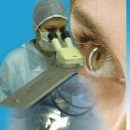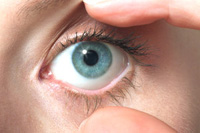During cataract occurs partial or complete clouds of lens, its transparency is lost and only a small part of the light rays fall into the eye, so the vision drops, and the person sees fuzzy and blurry. In modern ophthalmological centers and clinics, cataract treatment is carried out using the Ultrasonic Focoemulsification technique with an implantation of an artificial intraocular lens.
Content
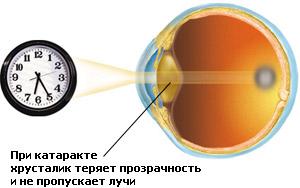 Cataract is one of the most common eye diseases among older people. Crystal of human eyes — This «Natural lens» transmitting and refracting light rays. Crystal Located inside the eyeball between the iris and the vitreous body. In my youth, human lens is transparent, elastic — can change its shape, almost instantly «Putting focus», Due to which the eye sees the same well and close to, and away. During cataract occurs partial or complete clouds of lens, its transparency is lost and only a small part of the light rays fall into the eye, so the vision drops, and the person sees fuzzy and blurry. Over the years, the disease progresses: the area of turbidity increases and the vision decreases. If you do not receive treatment in a timely manner, cataract can lead to blindness.
Cataract is one of the most common eye diseases among older people. Crystal of human eyes — This «Natural lens» transmitting and refracting light rays. Crystal Located inside the eyeball between the iris and the vitreous body. In my youth, human lens is transparent, elastic — can change its shape, almost instantly «Putting focus», Due to which the eye sees the same well and close to, and away. During cataract occurs partial or complete clouds of lens, its transparency is lost and only a small part of the light rays fall into the eye, so the vision drops, and the person sees fuzzy and blurry. Over the years, the disease progresses: the area of turbidity increases and the vision decreases. If you do not receive treatment in a timely manner, cataract can lead to blindness.
According to the World Health Organization, about 17 million people suffer from the Cataract, mainly at the age of 60. In 70–80 years of cataract presents in 260 men and 460 women per 1000 people, and after 80 years — Practically everyone. Statistics show that 20 million people in the world of cataracts cause blindness!
Causes of cataracts
The factors contributing to the development of cataracts include:
- Genetic predisposition
- Eye injury (chemical, mechanical, contusion injuries)
- Various eye diseases (including glaucoma, myopia of high degrees)
- Endocrine disorders (metabolic disorders, diabetes, avitaminosis)
- Raewy, microwave and ultraviolet irradiation
- long-term reception of a number of drugs;
Increased radiation - Unfavorable environmental setting
- Toxic poisoning (naphthalene, dinitrophenol, Tallium, mercury, ardor)
- smoking
Symptoms of Cataract
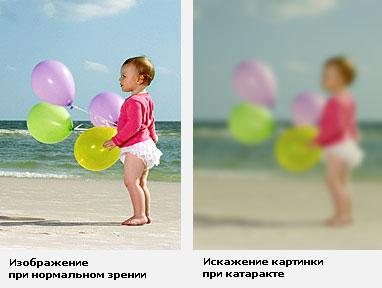 Ancient Greeks called this disease — karataraktes that translated means a waterfall. When cataracts vision is blurred, and the person sees, as if through the falling water or through the stamped glass. With the development of the disease, everything is sharply felt flashed before the eyes of strips, strokes and spots, halisters around the items in bright light, light-duct,. Often there are difficulties when reading, writing, working with small details, sewing. As «Maturation» cataracts color pupil instead of black becomes white.
Ancient Greeks called this disease — karataraktes that translated means a waterfall. When cataracts vision is blurred, and the person sees, as if through the falling water or through the stamped glass. With the development of the disease, everything is sharply felt flashed before the eyes of strips, strokes and spots, halisters around the items in bright light, light-duct,. Often there are difficulties when reading, writing, working with small details, sewing. As «Maturation» cataracts color pupil instead of black becomes white.
How fast ripens cataract?
- According to observations of ophthalmoshurgeons, 12% of patients occurs fast-moving ripening of cataracts. Since the development of the disease to the extensive cloud of lens, requiring immediate surgical intervention, there are 4–6 years.
- In 15% of patients, there is slowly progressive cataracts that develop within 10–15 years.
- In 70% of patients, the progression of cataract occurs in 6–10 years. Required compulsory surgical intervention.
Cataract treatment
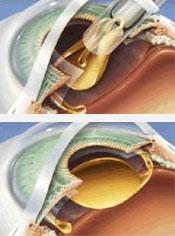 In modern ophthalmological centers and clinics, cataract treatment is carried out using the Ultrasonic Focoemulsification technique with an implantation of an artificial intraocular lens. With the help of a special probe, the crustal ultrasound turns into an emulsion, after which it is derived from the eye and the flexible intraocular lens is placed on its place with the help of the injector. Such a lens independently unfolds inside the eye and fixed reliably.
In modern ophthalmological centers and clinics, cataract treatment is carried out using the Ultrasonic Focoemulsification technique with an implantation of an artificial intraocular lens. With the help of a special probe, the crustal ultrasound turns into an emulsion, after which it is derived from the eye and the flexible intraocular lens is placed on its place with the help of the injector. Such a lens independently unfolds inside the eye and fixed reliably.
Local drip anesthesia used during the facoemulsification of cataracts, eliminates the load on cardio — Vascular system and other organs. High security and reliability of this method allows you to operate patients of all age groups. So the very small patient of the clinic «EXIMER», which they removed the cataract, it was only 3 weeks, and the most elderly — 104 years.
After the facoemulsification, the patient sees well enough after a few hours, and the maximum acuity of vision is restored over a period of 2 days to 1 week. Visual and physical rehabilitation is minimized. Many patients are already the next day after the operation continue to lead their familiar lifestyle.
If you wait for treatment
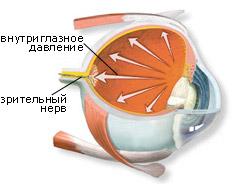 When tightening with treatment during the development of cataracts, a smooth crystal is compacted and increases in size, occupying more and more place inside the eye. The eye pressure increases and the internal structures of the eye, including the retina and the optic nerve, are experiencing increased loads. And can develop glaucoma. When glaucoma, the loss of visual functions is irreversible. The process of treating glaucoma itself is aimed at stopping the further development of the disease, but to restore the already lost — impossible.
When tightening with treatment during the development of cataracts, a smooth crystal is compacted and increases in size, occupying more and more place inside the eye. The eye pressure increases and the internal structures of the eye, including the retina and the optic nerve, are experiencing increased loads. And can develop glaucoma. When glaucoma, the loss of visual functions is irreversible. The process of treating glaucoma itself is aimed at stopping the further development of the disease, but to restore the already lost — impossible.
Which lens to choose?

 After the operation on the removal of cataracts in the place of natural lens is implanted with artificial lens (intraocular lens). To the selection of intraocular lenses, doctors are especially careful. After all, it depends on how the patient will see after the operation. That is why, before carrying out operation, all patients undergo a complete diagnostic examination of the entire visual system. Based on the data obtained during diagnostics and based on the anatomical and optical features of the eye, the doctor individually for each patient calculates the refractive force of the lenses. The age of the patient, the function of activity, wishes.
After the operation on the removal of cataracts in the place of natural lens is implanted with artificial lens (intraocular lens). To the selection of intraocular lenses, doctors are especially careful. After all, it depends on how the patient will see after the operation. That is why, before carrying out operation, all patients undergo a complete diagnostic examination of the entire visual system. Based on the data obtained during diagnostics and based on the anatomical and optical features of the eye, the doctor individually for each patient calculates the refractive force of the lenses. The age of the patient, the function of activity, wishes.
Now the most popular aspheric and multifocal lenses. Aspherical lenses are designed specifically for the correction of spherical aberrations (distortions). They allow you to get high-quality, contrast and clear image, both in the day and in the evening. A multifocal lenses due to the special design of optics make it possible to achieve maximum visual acuity as near and away.
If you have vision problems, then the doctors of the clinic «EXIMER» ready to provide you with any ophthalmic help at the most modern level. All questions you are interested in. You can set on-line in mode. When recording on reception via the clinic's website, a 5% discount on full computer diagnosis with an ophthalmologist is consulted.
We will be happy to help you and be healthy!
Contact Clinics «EXIMER»:
- G. Moscow, ul. Marxist, D.3. Tel.: (495) 620-35-55
- G. St. Petersburg, Apraksin Per., D. 6.Tel.: (812) 325-55-35
- G. Kiev, ul. Dimitrov, D. 5 B. Tel.: (044) 238-68-00
- G. Novosibirsk, ul.Frunze, 57a. Tel.: (383) 218-70-55
- G. Nizhny Novgorod, ul. Engelsa, D. one. Tel.: (831) 223-73-03
- G. Rostov-on-Don, Guards Per., D.4. Tel.: (863) 291-72-72

